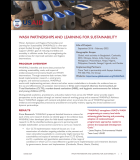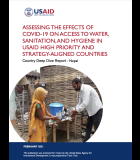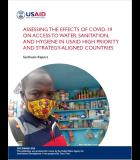Suaahara (Good Nutrition)
USAID has made substantial contributions to health and nutrition in partnership with the Government of Nepal (GON) and other external development partners. As part of its strategy to strengthen the country’s health and nutrition programs, USAID, in consultation with the Ministry of Health and Population (MOHP) and relevant partners, designed the Integrated Nutrition Project --‘Suaahara’ (Good Nutrition).
Suaahara is a five-year, $46 million comprehensive community-focused project dedicated to improving the health and nutritional status of pregnant and lactating women and children under two years of age, thereby directly addressing the vulnerable points of development which result in chronic undernutrition or stunting. The project focuses on improving: nutrition; maternal, newborn, and child health (MNCH) services; reproductive health/family planning services; water, sanitation and hygiene; and home-based gardening in 20 districts.
The project works within the government system, primarily through Female Community Health Volunteers (FCHVs) and other community extension workers. FCHVs disseminate health messages, services and commodities at the household level and through mothers’ group discussion forums. For 20 years, the GON, other donors, and USAID have increased the knowledge and skills of this cadre of FCHV’s and their female neighbors through a family health-based curriculum. The volunteers are now building on that knowledge and developing demonstration farms encompassing poultry farming, productive sanitation, integrated pest control and nutritious vegetables.
Suaahara integrates health, nutrition, agriculture and food security activities. Complementary nutrition and hygiene education, small-scale backyard farming, and greater access to and understanding of the need for a variety of healthy foods will improve the impact of agriculture production and economic development on nutritional status in the Mid- and Far-West regions. Project approaches support the Government of Nepal’s Multisectoral Nutrition Plan 2013-17 and the Hygiene and Sanitation Master Plan 2011-2015.
Activity Description
- Provide training on a package of integrated and evidence-based essential nutrition actions for health and non-health service providers, Female Community Health Volunteers, mothers’ groups, and household decision makers, especially mothers-in-law and husbands.
- Support improvements in nutrition and maternal and child health services through a focus on quality improvement.
- Promote good water, sanitation and hygiene practices at the household and community level in support of GON efforts to achieve “open defecation-free” status for key districts.
- Enhance health workers’ capacity to provide effective counseling on healthy timing and spacing of pregnancy as critical for good health and nutrition.
- Mainstream homestead food production activities (vegetables and backyard poultry farming) to increase year-round access to diverse and nutritious foods at home.
- Enhance multi-sectoral coordination on nutrition between the GON and others actors for the effective planning, implementation and monitoring of integrated nutrition activities via technical assistance to national working groups.
Expected Outcomes
- Reduce the prevalence of stunting, wasting and underweight among the children under two years of age in 20 target districts.
- Improve infant and young child feeding practices.
- Increase the consumption of diverse and nutritious foods by pregnant and lactating women and their families.
- Increase the use of quality health services, especially for the management of diarrhea and acute respiratory infections.
- Improve the utilization of quality maternal health services.
- Reduce the prevalence of diarrhea among children under five years of age.
- Increase the number of households using improved drinking water sources.
- Increase the number of households using improved sanitation facilities.
- Strengthen multi-sectoral coordination on nutrition among GON ministries and other stakeholders.
- Increase the number of USAID-supported service delivery sites that offer family planning services.
Actual Outcomes
- Built the capacity of 153,977 1000-day mothers and their family members
- Trained 1,628 agriculture and livestock workers
- 6,996 households were certified as “clean house”.
- 37,179 hand washing stations were established in schools, health facilities
- 13,205 disadvantaged group households supported with toilet/sanitation materials
- 121 VDCs supported for open-defecation free declaration
- Increased the number of households with water and soap at handwashing station from 57% in 2013 to 75% in 2015.
- Increased the number of households with toilets from 78% in 2013 to 93% in 2015.
- The prevalence of diarrhea has decreased by 5 percentage points between 2013 and 2015.





